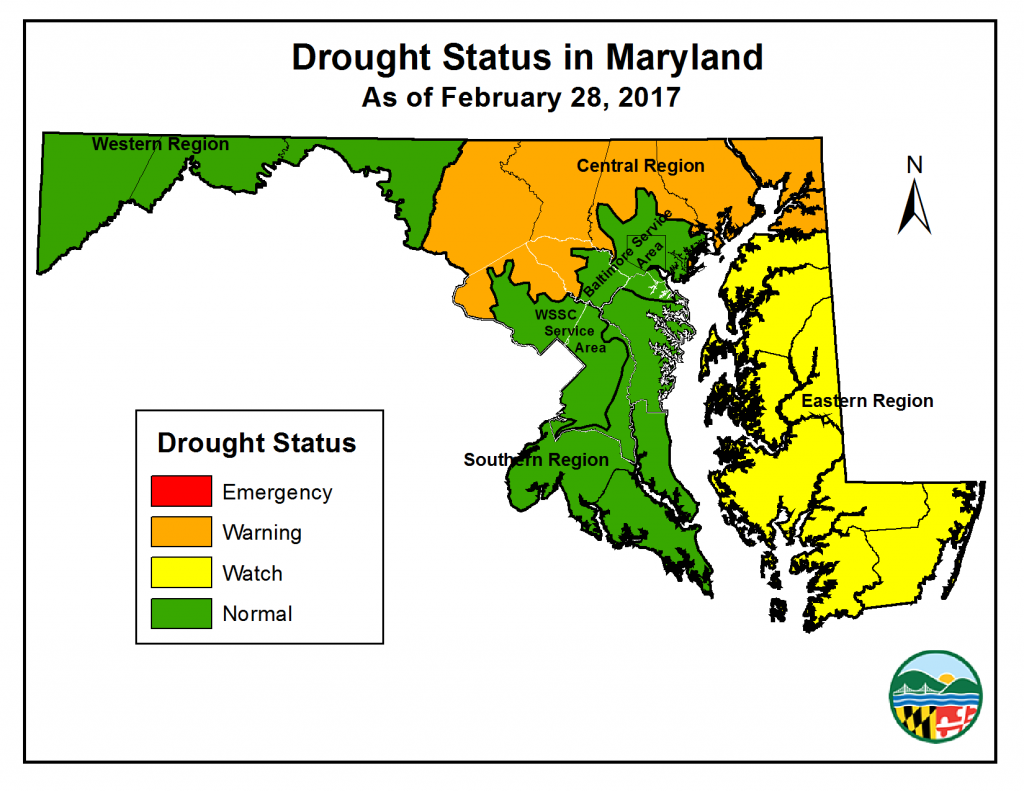Drought Warning Issued for Central Maryland
MEDIA CONTACTS:
Jay Apperson
(410) 537-3003
jay.apperson@maryland.gov
Drought Warning Issued for Central Maryland
Continuing lack of precipitation leads to below-normal stream flows and declining groundwater levels in Central Maryland; Eastern Maryland in “watch” status
Baltimore, MD (March 9, 2017) – The Maryland Department of the Environment today issued a drought warning for the Central region of Maryland.
The department issued the warning based on a continuing lack of precipitation that has led to lower-than-normal stream flows and groundwater levels for this time of year in parts of Maryland. During a drought warning, the Maryland Department of the Environment increases oversight of water supply conditions and encourages citizens and businesses to voluntarily reduce their water use.
The Central region includes Baltimore, Carroll, Cecil, Frederick, Harford, Howard and Montgomery counties, except for areas served by the Baltimore City or Washington Suburban Sanitary Commission public water systems.
A drought watch is in effect for the Eastern region of Maryland: Caroline, Dorchester, Kent, Queen Anne’s, Somerset, Talbot, Wicomico and Worcester counties. Rainfall and stream flow levels are below normal in that region.
Overall conditions in all other regions of Maryland – including areas served by Baltimore City and Washington Suburban Sanitary Commission public water systems, which have significant water reserves – remain within normal ranges.
“Water conservation and efficiency are always smart– especially during extended periods of reduced rainfall,” said Maryland Secretary of the Environment Ben Grumbles. “The Department of the Environment is stepping up its efforts to monitor conditions and work with local water systems and drought response coordinators to sustain our state’s most precious liquid asset.”
Information on current conditions and Maryland’s drought management plan is available on MDE’s website at http://bit.ly/MDdrought.

Assessing drought
Maryland uses the U.S. Army Corps of Engineers’ definition of drought: “periods of time when natural or managed water systems do not provide enough water to meet established human and environmental uses because of natural shortfalls in precipitation or stream flow.”
The Department of the Environment monitors precipitation, stream flow, groundwater levels and reservoir storage to determine the drought status for regions of the state. The Department has also been coordinating closely with the Susquehanna River Basin Commission and the Interstate Commission on the Potomac River Basin as they monitor conditions for areas served by the Susquehanna and Potomac Rivers.
Maryland defines drought conditions in stages – from normal to watch to warning to drought emergency. If two or more of the four indicators for a region reach watch, warning, or emergency levels, then the region is placed in the corresponding status.
Rainfall in the Central region since Sept. 30, 2016, is on average 6.5 inches below normal, or about 61 percent of normal. Rainfall in the Eastern region since Sept. 30, 2016, is on average 4.7 inches below normal, or about 71 percent of normal.
The “water year” used to evaluate precipitation begins October 1 – a natural dividing point, as precipitation in the first six months of the water year typically replenishes the groundwater supply for increased water use starting in the spring. Groundwater levels in the Central region were much lower in February 2017compared to February 2016, but not as low as they were in February 2002, the year of Maryland’s last significant water supply drought
When a drought warning is issued, conditions are evaluated weekly. The department’s website includes information on current and recent conditions.
During a declared drought emergency, mandatory restrictions on non-essential water use are implemented. Local water systems, municipal and county governments can require water-use restrictions at any time due to local conditions, but the Department of the Environment is not at this time aware of any local jurisdictions implementing voluntary or mandatory restrictions due to conditions.
Drought warning – what you can do
Watches and warnings are intended to raise awareness of water conservation. The Department of the Environment provides tips on conserving water in the home. They include: running your dishwasher or washing machine only with full loads, consider water use when purchasing new appliances and installing WaterSense certified low-flow toilets and showerheads.
More tips and information for households, businesses and industry are available on the Department of the Environment website at http://bit.ly/MDwaterconservation.
# # #
